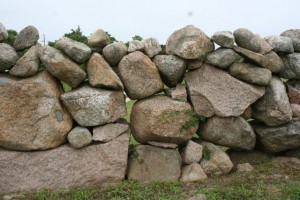
To answer the question of whether stone walls are landforms, I like to start with the word “landscape.” According to Webster’s this 16th century word derives from the Dutch landschap, meaning “land + ship.” Tracking back through the etymology of the Oxford English Dictionary, however, indicates that the concept clearly predates the 5th century A.D.
Being empirical, ignoring the conventions of art history, and based on the way I hear the term used colloquially and professionally, a landscape is not a place, but an image (visual or mental) of a place that consists of physical entities and that can be seen and appreciated by the human eye from a single spot, often by a single glance. Technically, its the cone of human vision at the familar scale of village, coast, or rural geography. A human presence is always either present or suggested.
In contrast, a landform is easy to define because no cultural connotation is required. Nor is there a required scale. To geologists like me, a landform is any natural discrete physical object composed of “land” (rock or earth) that can be observed in its entirety. Because humans were visual primates long before they became stone-age men and women, the form of the landscape (landform) has held higher priority over the equally important elements of the material they consist of, the process creating them, and the time involved.
Typically, a landscape is younger and larger than the set of landforms within the scene. The only exception to this commonality is when the natural scene contains little or no topographic or lithologic variety, for example a sand plain as smooth as a glassy sea such as the the Llano Estacado of west Texas.
So are New England stone walls landforms? It think yes, even though I included the term “natural” in my definition. First, the vast majority of walls are no more complex than many natural forms, a star-dune for example, or the herringbone structure on a fine-sand beach. To exclude them as landforms because they were built by humans is to suggest that humans are not natural. I refuse to accept this false, and damaging dichotomy.